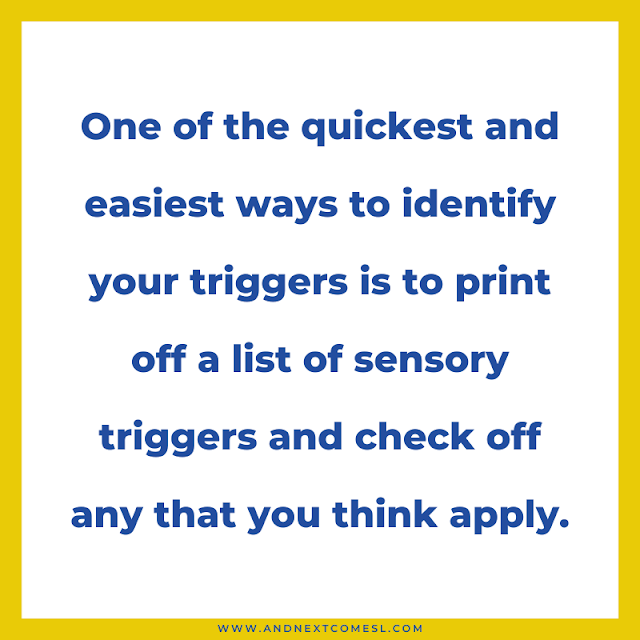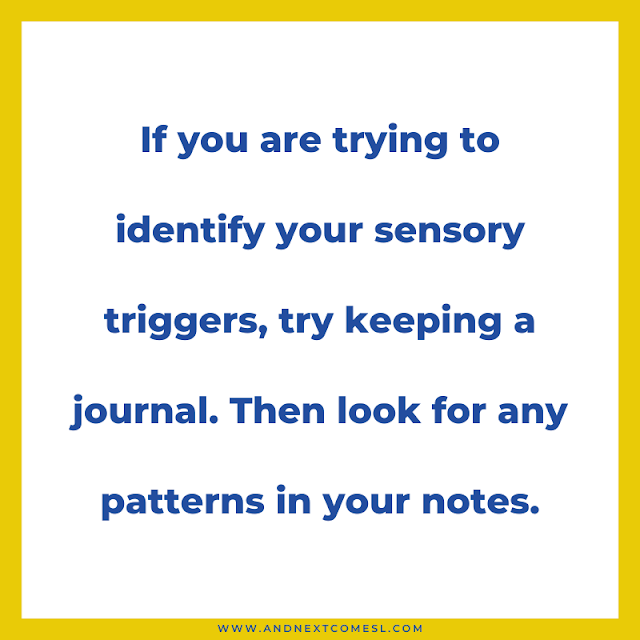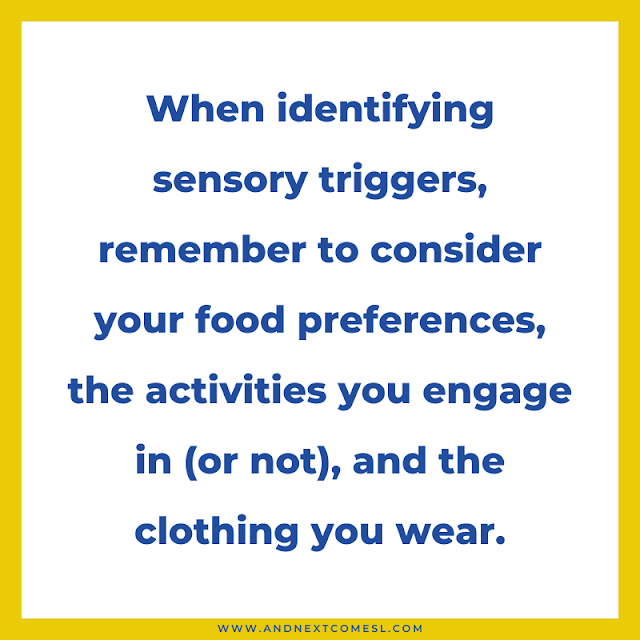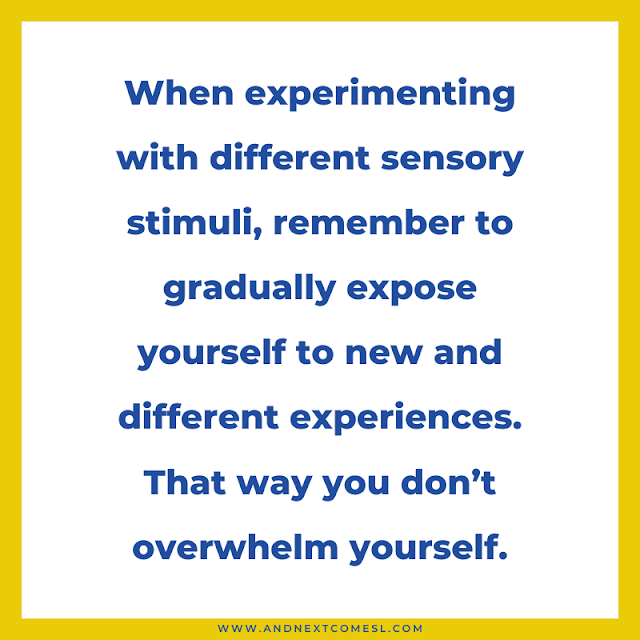As a parent, you probably already know that it's important to be able to identify your child's sensory triggers. You know, the things that cause significant sensory issues and responses in your child.
However, it can be tricky to know what some of those triggers might be, especially if you're new to sensory processing in general. Or, if your child is young or non-speaking and can't really tell you what's going on. They might not be able to give you insight beyond just observing their behavioral or emotional responses.
Likewise, if you have sensory processing differences yourself, you might be struggling to identify your own triggers. Maybe you have zero idea where to start or maybe you have an inkling what some of them might be, but need a bit more guidance.
Regardless, we're going to go over some tips and strategies for how to identify sensory triggers, whether those triggers are your own or your child's. That way you'll be better equipped to accommodate your own (or your child's!) sensory needs and make a sensory safety plan.
Tips for How to Identify Sensory Triggers
Now, there are many different ways you can approach identifying your triggers so you might want to use as many of these ideas and suggestions as you can. That way you can get a more complete picture of what your (or your child's) sensory profile might be.
1. Learn about sensory processing
It's so much easier to identify your triggers if you have a good grasp of the basics. After all, you'll need to be able to know if you are hyposensitive to some sensory information or hypersensitive to others. And it helps to know what sensory triggers are in the first place. So I recommend that you:
- Learn about the 8 senses
- Understand that there are different patterns of sensory processing
- Read up on what sensory triggers are, as well as some common examples
2. Get feedback from others
You don't have to identify your sensory triggers all by yourself. There are lots of people in your life who could likely give you some ideas or validate your suspicions. Here are some things to consider:
- Consult with professionals who are familiar with sensory processing, such as an occupational therapist
- Talk to anyone who regularly interacts with you or your child that you trust to see if they've noticed anything. Think family members, friends, caregivers, daycare workers, teachers, a close co-worker, and so on.
3. Use a sensory checklist
One of the quickest and easiest ways to identify your triggers is to print off a list of sensory triggers and check off any that you think apply. After all, it can be hard to sit there and come up with a list of triggers all on your own so having a concrete list of example ideas makes things a bit easier.
- Search for a sensory trigger checklist and find one you like. This 5 minute sensory checklist from Neurodivergent Insights is a great starting point. There is also a small example one included in the identifying sensory triggers social story.
4. Keep a journal
Start journaling and take note of your activities, events, emotions, and sensory experiences. Be sure to write down the time, day, location, and what you were experiencing. Then make note of your mood, your stress levels, any physical sensations, and your emotional reactions. All of this information can be so helpful when it comes to identifying your sensory triggers.
- Look for patterns in your notes. For instance, did a specific sensory experience cause overwhelm or distress multiple times? Or only at night? Or only when you were at a restaurant?
- Make note of whether or not certain types of sensory input consistently aligned with intense reactions, dysregulation, or negative feelings
- Observe any changes in the environment and write down what they are and how those changes impacted you
5. Reflect on past experiences
Think about past experiences where you may have experienced intense sensory responses, dysregulation, sensory overload, or meltdowns. Perhaps you can identify some patterns or some possible clues as to what might have cause discomfort or distress in these situations or experiences.
- Make note of these past experiences in a journal and try to include as much detail as you can about the event, your mood, your stress levels, environmental elements, day and time, etc.
- Talk with anyone who might have been with you during these experiences to see if they have any additional information to share with you (e.g., talk to a parent about a childhood experience that you remember)
- Consider things that you find soothing and think about why they might be soothing to you. Doing so might give you insight into some things that might be bothering you. For example, you find wearing headphones helps you stay regulated. Could that mean you have some noise sensitivity and that certain types of sounds are sensory triggers?
- Think about the types of sensory experiences that you actively seek out or avoid (see the next tip) and see if you can identify why you might be drawn to certain experiences while you avoid others
6. Make a list of things you already dislike or avoid
It can be helpful to consider the things you already dislike and avoid and think about whether there might be some sensory underpinnings to them. For instance, let's say you hate wearing jeans so you never wear them. Is it because of the fabric? If so, then keep asking yourself why that is. Doing so can help you discover any possible sensory sensitivities.
You can repeat the process with other things you dislike in your day-to-day life and provide more sensory stimulation than you can handle. Here are some suggestions to get you started:
- Think about your food preferences and make a list of foods you don't enjoy. You could use this free tracking sheet to get you started. Then try to look for patterns in terms of texture, type of food, preparation, spices, smell, temperature, etc.
- Consider the activities you engage in (or not) and why you may or may not enjoy those activities. Are there any consistent patterns? Are there some past experiences that didn't go so well? Think about the environment of those activities, the number of people, the lighting, the sounds, the smells, etc.
- Think about the clothing you wear and see if there are certain fabrics, fits, textures, designs, or other sensory aspects to consider. Think seams, tags, pockets, stretchiness, looseness, softness, colors, buttons, collars, etc.
7. Look for physical & emotional signs
Pay attention to how your body feels during certain situations and consider the physical signals in the body, as well as the emotional responses, that you notice. Those signals can help you identify some potential triggers. Some physical signs that you can look for include sweating, tense muscles, headaches, covering ears, increased heart rate, etc.
- List any physical or emotional signs that you notice in a journal (alongside whatever the event or stimuli is) to see if you can find any patterns
- Use an app or something like a Fitbit to help keep track of physiological responses such as heart rate, oxygen levels, etc.
- Try out different types of sensory experiences and stimuli and pay attention to how your body feels during those experiences (which leads me to my next tip)
8. Experiment with different sensory stimuli
Experimenting can be a great way to see what makes you feel uncomfortable. So try out different types of sensory input and expose yourself to a wide variety of experiences, situations, or events to see how you react. It's also a great way to learn about your limits and boundaries when it comes to different sensory stimuli.
- Gradually expose yourself to new and different experiences so you don't overwhelm yourself
- Create a plan with the advice and support of a professional, such as an occupational therapist
- Observe how you respond to things and record those responses in a journal so you can look for patterns
- Try out different appropriate sensory activities, such as sensory bins or light table activities, to see how you respond to different textures, experiences, and stimuli
- Recognize that your sensitivity to certain things can change and fluctuate so identifying sensory triggers is a personal and ongoing process
Need Help Figuring Out Your Sensory Triggers? Try this Social Story!
If you need some help understanding the things that cause sensory issues for you, try this sensory triggers social story from the shop. It is editable so you can customize it to fit your needs. It also covers a lot of the tips from above.
Grab your copy of the identifying sensory triggers social story
Summary of Tips for Identifying Your Sensory Triggers
Whether you are trying to identify your own sensory triggers or those of your child, here are some things you can do to figure them out:
- Learn about sensory processing
- Get feedback from others, including a professional familiar with sensory processing
- Use a sensory checklist to get ideas of possible triggers
- Keep a journal and look for patterns
- Reflect on past experiences
- Make a list of things you already dislike or avoid
- Look for physical and emotional signs
- Experiment with different sensory stimuli
Hopefully you found these tips for how to identify sensory triggers helpful. Good luck!













